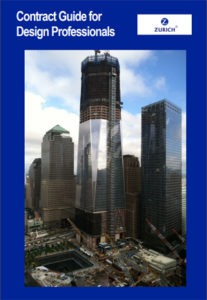Indemnification Clause
A properly worded indemnification clause is critical to reducing risk in a construction contract. An indemnification clause may include any, or all, of three distinct obligations, including to (1) indemnify, (2) defend, and (3) hold harmless the client. Indemnify means to reimburse your client following a loss. [printfriendly]
Chapter on Indemnification Clauses
Kent Holland’s chapter on indemnification clauses is included here. Details include avoiding uninsurable losses.
a/e ProNet
The a/e ProNet website provides numerous educational articles and papers addressing design professional liability and risk management, including indemnification clauses and limitation of liability clauses. Three articles by Kent Holland addressing indemnification clauses are available at a/e ProNet.
Additional articles on this website.
- Indemnification Clauses, Part 4 Indemnification Clause Should Limit Indemnification to Third Party Tort Claims
- Indemnification Clauses, Part 5 The Changing Face of Indemnity by Brian K. Stewart, Esq., Collins, Collins, Muir + Stewart, LLP. Also found here on the a/e ProNet website.
The a/e ProNet members are independent, specialist insurance brokers. Each has demonstrated exceptional knowledge, service, and commitment to the design community before receiving an invitation to join this long-standing professional network. Together, these brokers represent more than 16,000 architecture and engineering firms of all sizes and across all disciplines.
Related Articles by Kent Holland
Sample Indemnification Clause
Kent Holland provides six sample indemnification clauses, each addressing unique aspects of indemnity.
Sample 1:
Consultant shall indemnify and hold harmless the Client, its officers, directors, employees, from and against those liabilities, damages and costs that Client is legally obligated to pay as a result of the death or bodily injury to any person or the destruction or damage to any property, to the extent caused by the willful misconduct, negligent act, error or omission of the Consultant or anyone for whom the Consultant is legally responsible, subject to any limitations of liability contained in this Agreement. Consultant will reimburse Client for reasonable defense costs for claims arising out of Consultant’s professional negligence based on the percentage of Consultant’s liability.
Sample 2: For California contracts must add that there is no duty to defend:
Consultant shall indemnify and hold harmless (but not defend) the Client, its officers, directors, employees, from and against those liabilities, damages and costs that Client is legally obligated to pay as a result of the death or bodily injury to any person or the destruction or damage to any property, to the extent caused by the willful misconduct, negligent act, error or omission of the Consultant or anyone for whom the Consultant is legally responsible, subject to any limitations of liability contained in this Agreement. Consultant will reimburse Client for reasonable defense costs for claims arising out of Consultant’s professional negligence based on the percentage of Consultant’s liability.
Sample 3: Instead of referencing BI and PD, reference “third party claims”
Consultant shall indemnify and hold harmless the Client, its officers, directors, employees, from and against those liabilities, damages and costs arising out of third party claims to the extent caused by the willful misconduct, negligent act, error or omission of the Consultant or anyone for whom the Consultant is legally responsible, subject to any limitations of liability contained in this Agreement. Consultant will reimburse Client for reasonable defense costs for claims arising out of Consultant’s professional negligence based on the percentage of Consultant’s liability.
Sample 4: Include a duty to defend in the main text for CGL type claims but add sentence at conclusion to carve out professional liability claims.
Consultant shall indemnify, defend and hold harmless the Client, its officers, directors, employees, from and against those liabilities, damages and costs arising out of third party claims to the extent caused by the willful misconduct, negligent act, error or omission of the Consultant or anyone for whom the Consultant is legally responsible, subject to any limitations of liability contained in this Agreement. Consultant will reimburse Client for reasonable defense costs for claims arising out of Consultant’s professional negligence based on the percentage of Consultant’s liability. The duty to defend shall not apply to professional liability claims.
Sample 5: A different way to address defense obligations:
The foregoing defend, hold harmless and indemnity obligations of this paragraph shall apply solely to any such causes of action, damages, costs, expenses or defense obligations covered by Consultant’s Insurance specified in this Agreement.
Sample 6: Instead of agreeing to indemnify for all damages, including reasonable attorneys fees, strike out the attorneys fees in the body of the indemnity clause and use the simple one sentence shown in the above examples for attorneys fees or use the following:
Consultant agrees to reimburse Client for reasonable defense costs, provided however that such obligation is limited to the portion of such costs equal to the percentage of Consultant’s liability as ultimately determined to be caused by the willful misconduct or negligence of Consultant using principles of comparative fault.
Indemnification Clause Articles from ConstructionRisk.com Reports
No Common law Indemnification Duty Owed by General Contractor to Project Owner for Subcontractor Employee Injuries Where GC Did Not Control and Supervise the Subcontractor’s Work
Where a general contractor performing a build-out for a store tenant (not the project owner) retained the services of a subcontractor for certain work and an employee of the subcontractor was injured by falling from a ladder, the project owner sued the contractor for...
The Expanding Reach of the Crawford Decision and the Impact On Construction Indemnity Agreements
By: Michael D. Wilson, Jr. Gordon Rees, LLP 275 Battery Street Suite 2000 San Francisco, CA 94111 (415) 986-5900 In the period since the California Supreme Court published the seminal decision in Crawford v. Weathershield (“Crawford”) and refused to consider or...
Indemnification Clause Requires Subcontractor to Indemnify Prime Contractor Regardless of Finding that Sub was not Negligent, and the Additional Insured Endorsement Requires Insurer to Cover the Prime for Damages not Caused by Sub’s Negligence
Where a pipeline was damaged when it was struck by sheeting being installed by a sub-subcontractor while installing lift stations along a pipeline previously installed by the prime contractor, the sub-subcontractor was found to be liable to its client (ECI...
Engineer Required to Indemnify Client for Costs of First Party Claim, Including Attorneys Fees to Extent Attributable to Engineer
Pursuant to a contractual indemnification clause, a trial court awarded damages of $810,000 in attorneys fees against an engineer in favor of a project owner, Wal-Mart Stores, Inc., on a jury verdict of $48,600 in actual property damages. Wal-Mart’s first party claim...
Assignee of Contract Indemnification Rights under a Design-Build Contract Stands in Shoes of Indemnitee and is Entitled to Recover Defense Costs
Where a firm (Parsons Infrastructure) entered into a contract to design and construct a soda ash processing plant for Kerr-McGee Chemical Corp (KM) and agreed to provide KM with a defense and indemnity against losses arising out of negligent performance of its work, ...



Connect